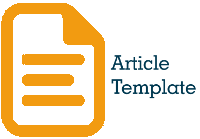APLIKASI PENGENALAN POLA SEBAGAI MEDIA PEMBELAJARAN MENULIS PADA ANAK USIA DINI
DOI:
https://doi.org/10.35457/antivirus.v15i1.1257Keywords:
media, learns, toddlersAbstract
Writing is part of the function of language as a means of communication. Writing in this case is certainly different from drawing or scribbling randomly. However, writing in the sense of writing a pen with a specific purpose is suitable, such as writing the letter 'a', then 'a' should not write 'd', 'p', 'q' or others. In today's technological developments, several mobile-based writing lessons have also begun to be introduced to children. However, some of the learning materials provided are still monotonous and do not provide correction for writing errors. Some of them only give examples of certain letters then the children imitate or give dotted lines on a letter then the children thicken the lines. This study takes a new approach, to create an integrated system that can correct children's writing so that it is correct. The system that will be developed is interactive in which the children write a letter and if it is correct, they will be given reward points and if it is wrong, they will be given feedback on the location of the error. For example a child wants to write the letter 'a' upside down or write 'a' with a line that is too long to become 'd', the system will give an error warning and the user can be able to write again.
Downloads
References
Munir. 2017. Pembelajaran Digital. Bandung. Alfabeta, CV. hlm. 1.
Anshori, Sodiq. 2016. Strategi Pembelajaran di Era Digital (Tantangan Profesionalisme Guru di Era Digital). Prosiding: Temu Ilmiah Nasional Guru (TING) VIII.
Diana, Andini. 2014. Peningkatan Motivasi Menulis Anak Usia 5-6 tahun melalui Penggunaan Media Komik. Jurnal Ilmiah VISI P2TK PAUDNI - Vol. 9, No.2.
Hariyani, Farida. 2016. Meningkatkan Keterampilan Menulis Huruf Pada Anak Usia Dini Kelompok B dengan Menggunakan Media Gambar. Jurnal Usia Dini, Juni 2016, Vol. 2, No.1.
Bakhri. Syamsul. 2019. Animasi Interaktif Pembelajaran Huruf dan Angka Menggunakan Model ADDIE. INTENSIF: Jurnal Ilmiah Penelitian dan Penerapan Teknologi Sistem Informasi, Vol.3 No.2.
Faroqi, Adam & Maula, Barikly. 2014. Aplikasi Multimedia Interaktif Pembelajaran Membaca, Menulis, Berhitung (Calistung). Journal Uinsgd, Edisi Agustus 2014 Volume VIII No. 2.
Arief, & Umniati. 2012. Pengembangan Virtual Class untuk Pembelajaran Augmented Reality Berbasis Android. Jurnal Pendidikan Teknologi dan Kejuruan. Vol 21 (2), P15.
Samuel. 2016. "Unity at 10: For better or worse game development has never been easier". Ars Technica. Diakses pada September 2018.
Takahashi, D. 2014. John Riccitiello sets out to identify the engine of growth for Unity Technologies (interview). Diakses di laman: https://venturebeat.com/2014/10/23/john-riccitiello-sets-out-to-identify-the-engine-of-growth-forunity-technologies-interview/ pada Februari 2018.
Persefoni, K & Tsinakos, A. 2015. Use of Augmented reality in terms of creativity in School learning. ICEC’15, p. 52.
Downloads
Published
Issue
Section
License
Authors who publish with this journal agree to the following terms:
- Copyright on any article is retained by the author(s).
- Author grant the journal, right of first publication with the work simultaneously licensed under a Creative Commons Attribution License that allows others to share the work with an acknowledgement of the work’s authorship and initial publication in this journal.
- Authors are able to enter into separate, additional contractual arrangements for the non-exclusive distribution of the journal’s published version of the work (e.g., post it to an institutional repository or publish it in a book), with an acknowledgement of its initial publication in this journal.
- Authors are permitted and encouraged to post their work online (e.g., in institutional repositories or on their website) prior to and during the submission process, as it can lead to productive exchanges, as well as earlier and greater citation of published work.
- The article and any associated published material is distributed under the Creative Commons Attribution-ShareAlike 4.0 International License











